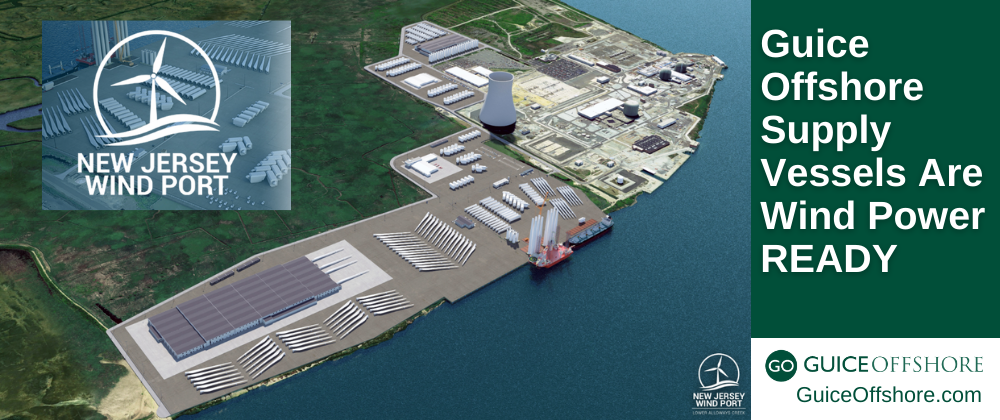The future of offshore wind energy for the United States keeps getting brighter as the New Jersey Economic Development Authority (NJEDA) and the Public Service Enterprise Group (PSEG) signed a lease in September 2021 that allows for a term of up to 78-years on land that will be home to the New Jersey Wind Port in Salem County, New Jersey,
Guice Offshore, an offshore supply vessel and offshore maritime transportation company, noted that the move further positions New Jersey as a hub for clean energy and the U.S. offshore wind industry. The port will provide a location for offshore wind farm infrastructure activities in which Guice Offshore is experienced, including essential staging, assembly, and manufacturing activities related to offshore wind along the U.S. East Coast.
With a modern fleet of dynamically positioned offshore supply vessels and mini-supply vessels, Guice Offshore has been involved in offshore wind infrastructure development, with our offshore vessels having performed a variety of functions across the various stages of wind energy projects, such as surveying, transportation of blades and turbines, installation, inspection, maintenance and crew transfer, among other jobs.
On September 23, 2021, the NJEDA announced that it will shortly be launching the next phase of its tenant selection process for the New Jersey Wind Port. The Wind Port, located on the Delaware River in Lower Alloways Creek in Salem County, will be a transformative, hub-style port serving offshore wind (OSW) projects in New Jersey and up and down the U.S. East Coast. The Port, which is due to commence construction this year, represents a new approach to economic development that will spur both job creation and opportunities for businesses throughout the offshore wind supply chain.
On September 9th, Governor Phil Murphy led the celebration for a groundbreaking at the site of the New Jersey Wind Port. The event kicked off a new chapter for the Wind Port, a first-in-the-nation infrastructure investment that will provide a location for essential staging, assembly, and manufacturing activities related to offshore wind projects on the East Coast. The event also included the signing of a project labor agreement (PLA) for the project and was followed by the signing of a 78-year lease between the NJEDA and PSEG for the site. The State is committed to using union labor to construct the Wind Port and intends to set a new standard for inclusion of minority and women workers and business owners. Construction is targeted to begin in 2021.
The New Jersey Wind Port has the potential to create up to 1,500 manufacturing, assembly, and operations jobs, as well as hundreds of union construction jobs in New Jersey, and projects supported by the Wind Port will drive billions of dollars in economic growth.
The NJEDA will shortly be seeking non-binding offers from OSW developers and component manufacturers on four parcels of property at the Port. Available properties include:
- Two parcels of property with the potential to be purpose-built for offshore wind marshalling, staging and final assembly of turbines; and
- Two parcels of property with the potential to be purpose-built for offshore wind turbine component manufacturing and assembly.
NJEDA anticipates that certain parcels will be available for sublease from 2023. A notice for the sublease of property will be issued in coming weeks and will be available at Bidding Opportunities – NJEDA.
“The New Jersey Wind Port is a strategic economic driver that not only furthers Governor Phil Murphy’s goal of 100 percent clean energy for New Jersey by 2050, but also presents extraordinary economic potential for businesses up and down the OSW manufacturing supply chain,” said NJEDA CEO Tim Sullivan. “Wind turbines are comprised of numerous elements, and each element in the manufacturing process represents an entry point for businesses and a need for skilled workers. These available properties offer incomparable access to opportunity in the heart of this rapidly emerging manufacturing hub.”
The Port is situated at the geographical center of the United States’ burgeoning OSW sector – with in excess of 38 gigawatts (“GW”) of committed and planned OSW projects along the East Coast, including 7.5 GW of committed projects off the coast of New Jersey.
Based on the current design, the Port will offer OSW industry tenants the following key features:
- Access to the Atlantic Ocean free of vertical restrictions;
- Upland acreage purpose-built for marshalling and component manufacturing;
- A wide approach channel from the main Delaware River Channel;
- A purpose-built heavy-lift wharf, comprising both delivery and installation berths; and
- Heavy-haul road connections between inland port parcels and the Wharf.
With proximity to 50 percent of current East Coast OSW development areas, and unmatched transportation connectivity to major United States and overseas cities, there is no better place to anchor and grow the nation’s OSW industry. Further information on the Port is available at: https://www.nj.gov/windport/.
Home to a high concentration of skilled labor, a well-established maritime industry and workforce, and a network of highly-regarded colleges and universities, New Jersey is ideally-placed to drive the development of the offshore wind industry in the United States.
The New Jersey Wind Port is located adjacent to PSEG’s nuclear generating site, which today provides more than 90 percent of New Jersey’s carbon-free electricity. Together, offshore wind and nuclear energy will deliver powerful support for America’s state and national clean energy ambitions.
“The New Jersey Wind Port is a transformational investment that will create hundreds of good jobs and drive billions of dollars of economic activity in South Jersey and throughout the State,” said NJEDA Chief Executive Officer Tim Sullivan. “This is a vital project that will help communities recover from the devastating impacts of the COVID-19 pandemic and move us closer to Governor Murphy’s vision for a stronger, fairer New Jersey economy. The NJEDA is proud to partner with PSEG to bring this valuable new infrastructure asset to life.”
“The lease signing with the NJEDA is cause for celebration as the New Jersey Wind Port will provide a foundation for even more carbon-free energy in our region,” PSEG Chief Operating Officer Ralph LaRossa said. “Alongside PSEG’s nuclear plants, the New Jersey Wind Port will establish South Jersey as the heart of New Jersey’s clean energy economy. By supporting the development of renewable offshore wind power, this lease and the facility to come will establish New Jersey as the destination for clean energy development, operations, training, skills, and innovation.”
“Salem County and South Jersey are already home to exceptional innovation, operations, and a workforce skilled in generating clean energy for millions of customers. And now, with the addition of the New Jersey Wind Port, PSEG is proud to support the state as we become the hub for development of carbon-free resources for the East Coast,” PSEG Nuclear President and Chief Nuclear Officer Eric Carr said. “PSEG and PSEG Nuclear welcome broad partnerships such as ours with the NJEDA and we look forward to continuing to drive innovation, growth, and investment in the clean energy economy.”
Offshore wind is a central component of Governor Phil Murphy’s Energy Master Plan to achieve 100 percent clean energy by 2050. As part of that plan, New Jersey has committed to producing 7,500 megawatts of offshore wind energy by 2035. Up and down the East Coast, offshore wind investment through 2035 is anticipated to exceed $150 billion.
The U.S. offshore wind industry is expected to create 83,000 new (direct) jobs by 2030, most of which will be in the Northeast and Mid-Atlantic. Through strategic investments and development, New Jersey can become a national leader in numerous portions of the offshore wind supply chain and become central to the clean energy economy.
The New Jersey Wind Port is located on an artificial island on the eastern shores of the Delaware River, southwest of the City of Salem. With its expansive footprint, lack of height restrictions, and easy access to the Atlantic Ocean’s wind farm lease areas, the Wind Port is one of a select few ports on the East Coast that can house offshore wind turbine marshalling and manufacturing. A key component of offshore wind turbine marshalling is the vertical assembly of turbine towers, which are hundreds of feet tall and cannot fit beneath bridges, power lines, and other naturally-occurring barriers that would impose height restrictions. No other port in the region is able to support the marshalling and manufacturing operations that will take place at the Wind Port.
Job Creation
The New Jersey Wind Port has the potential to create more than 1,500 manufacturing, assembly and operations jobs, as well as hundreds of construction jobs. Many positions at the Wind Port will be trade jobs and require skill certifications, like welding or an electrician’s license, but will not require a college degree. The construction phase of the Wind Port also will create hundreds of union jobs.
Last week, Construction Manager (CM) AECOM-Tishman signed a project labor agreement (PLA) with the United Building Trades Council of Southern New Jersey AFL-CIO. The NJEDA is also working with AECOM-Tishman to ensure at least 25 percent of subcontractors for the port construction are small businesses and at least 15 percent are women-, minority-, or veteran- owned. The Wind Port project also includes worker diversity goals of 18 percent people of color and 6.9 percent women.
The New Jersey Wind Port site was selected in June 2020 after a 22-month assessment process, including engagement with industry, government, and environmental stakeholders. The NJEDA has been preparing the site and finalizing design since summer 2020. It is more than five miles from the nearest New Jersey residential area and provides ample space to grow operations over time.
About the New Jersey Economic Development Authority
The New Jersey Economic Development Authority (NJEDA) serves as the State’s principal agency for driving economic growth. The NJEDA is committed to making New Jersey a national model for inclusive and sustainable economic development by focusing on key strategies to help build strong and dynamic communities, create good jobs for New Jersey residents, and provide pathways to a stronger and fairer economy. Through partnerships with a diverse range of stakeholders, the NJEDA creates and implements initiatives to enhance the economic vitality and quality of life in the State and strengthen New Jersey’s long-term economic competitiveness.
To learn more about NJEDA resources for businesses call NJEDA Customer Care at 609-858-6767 or visit https://www.njeda.com and follow @NewJerseyEDA on Facebook, Twitter, Instagram, and LinkedIn.
About PSEG
Public Service Enterprise Group Inc. (PSEG) (NYSE: PEG) is a publicly traded diversified energy company with approximately 13,000 employees. Headquartered in Newark, N.J., PSEG’s principal operating subsidiaries are: Public Service Electric and Gas Co. (PSE&G), PSEG Power and PSEG Long Island. PSEG is a Fortune 500 company included in the S&P 500 Index and has been named to the Dow Jones Sustainability Index for North America for 13 consecutive years (https://corporate.pseg.com).
New Jersey’s Wind Council and WIND Institute to address New Jersey Wind Port public policy needs
The WIND Institute will coordinate and galvanize cross-organizational workforce, research, and innovation efforts to support New Jersey as a leader in offshore wind.
The WIND Institute will be legislatively established as an independent authority with a corollary nonprofit. To ensure the WIND Institute complements ongoing market development efforts and addresses unmet needs, the WIND Council, a cross-governmental coordinating effort, assessed the state of the offshore wind industry in New Jersey, conducted a gap analysis of workforce assets in New Jersey, and facilitated discussions with a wide range of stakeholders. Together, these inputs shaped the WIND Council’s recommendations for the WIND Institute.
Read the WIND Council’s full report here
The NJEDA recognizes that immediate action is needed to address the industry’s short-term workforce development needs and lay the groundwork for research and innovation. As the WIND Institute is established, NJEDA will work in partnership with State agencies to implement.
More news headlines about the New Jersey Wind Port


